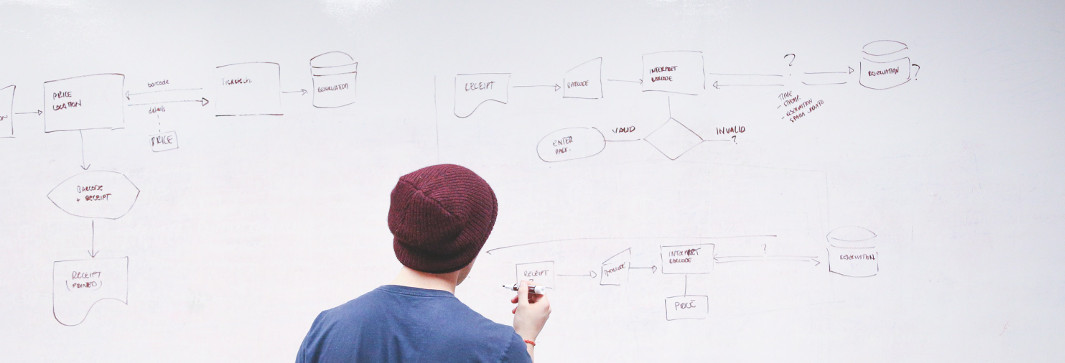
Measuring the Success of Startup Collaborations
July 30, 2019
aumentoo Next Generation
January 23, 20205 Tips on how Companies can Successfully Drive Innovation
66% of organizations will not survive without innovation
...however...
70% of corporates rate themselves as medium to weak innovators
Innovations do not always have to be the next big, groundbreaking invention such as the smartphone. Innovations can also be simple changes of processes, products or technologies that make everyday life or work easier. Banalities that arise from good ideas, sneaking into everyday life and that no one can think away anymore.
Often, however, companies implement wrong or no methods to bring forth innovation - you do not become an innovator by simply having a creative workshop or by situating a football table in the break room.
Innovation management is more of a continuous process that should be rooted in the corporate development and culture as well as in the minds of the employees themselves in order to be successful.
During numerous conversations with our customers and innovation experts, we have learned how even large companies can successfully generate innovations.
We have summarized our findings in the following 5 tips:
Often, however, companies implement wrong or no methods to bring forth innovation - you do not become an innovator by simply having a creative workshop or by situating a football table in the break room.
Innovation management is more of a continuous process that should be rooted in the corporate development and culture as well as in the minds of the employees themselves in order to be successful.
During numerous conversations with our customers and innovation experts, we have learned how even large companies can successfully generate innovations.
We have summarized our findings in the following 5 tips:
1 Focus on the Human Resource
As the human being is the innovation enhancer, the focus should lay on this resource as well. Corporate development not only means driving the development of the company forward but also changing the behaviour and work itself of people in the company.Therefore, a good corporate development requires employees to face changes and accept them. In order to implement a successful change management in the company, it is essential to create a culture welcoming communication and transparency, to encourage discussions, to provide regular feedback and to appreciate the performance of the employees accordingly. This culture does not necessarily have to be lived from top to bottom of the workforce - according the top down principle - but rather realized together.
However, senior managers should have a positive attitude to change and be a good example.
2 Plan and Set an Innovation Budget
In order to be able to innovate, a budget must of course be set and made available to the innovators. At the same time, the companies should be aware of the fact that the given budget could be completely consumed without having created a disruptive innovation or the next unicorn. Companies should therefore be prepared to invest money, resources and time, even if they run the risk to be left with the debts. In either way, the innovation process, if managed properly, can help gain experience and important insights. Maybe interesting ideas are created that in turn lead to further promising developments.You can only help people, who are passionate about something, who want to innovate, who have an idea if you also reserve a flexible budget for innovation - according to the motto try it, "fail fast fail cheap". Maybe the next big thing will evolve from it...You have to have this ambivalence. I have to be able to spend, but I also have to be able to accept mistakes.
3 “To Err is Human" - Implement a Failure Culture
For most of the people, mistakes and failures are a big taboo issue. Nevertheless, failures are part of life and part of the innovation process. After all, not every good idea shoots through the roof and thrills millions of people. Often enough, products and services are developed where the initial ideas were good, but were not perceived as such by customers.There are several reasons for this, including a misconceived marketing strategy, the unwillingness of customers to try the new product, or just the wrong time and place.As a result, it is important for corporates, and for the human being as well, to admit mistakes and from a company's perspective to implement a culture that accepts mistakes and that allows employees to learn from them.
4 Promote Collaboration
In general, corporate culture should not only allow mistakes, but also promote collaboration and participation of the employees. Thus, all the stakeholders should be involved as early as possible in the innovation process in order to create customer-oriented products and services as well as to reduce the number of undesired or unsuccessful developments.The stakeholders might be the customers themselves, but also team members of the sales or support department, who are closer to the end user and thus are able to better evaluate which functionalities should be focused upon and which not.
Participation implies that colleagues from different departments work together successfully, sharing information, retracting elbows, as well as turning off the corporates’ widespread silo thinking.
5 Develop and Launch Prototypes Fast
The next step in the innovation process involves developing a prototype together with the various stakeholders. This development should be launched as quickly as possible on the market and make it available to the customers, according to the motto "Act now, apologize later".Often companies tend to wait until the product is perfect and everything works tip-topically. However, this leads to the risk of developing and implementing features that are not relevant for customers, in the worst case they even represent an exclusion criterion for buying the product. In highly competitive markets, waiting too long and perfecting products can lead to already placed and established products of competitors, not hesitating to enter the market quickly.
Consequently, developing products and services by employees from various departments together with users, bringing together stakeholders and enhancing collaboration as well as participation is a good way to successfully create innovations internally.





